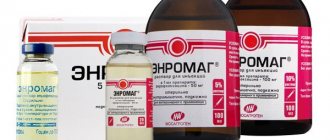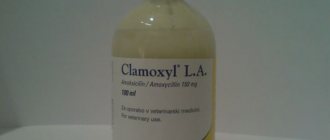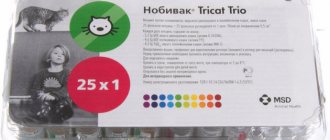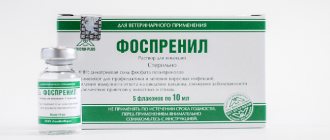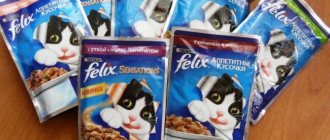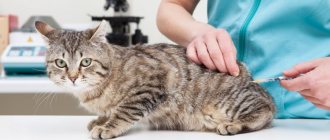Synulox is a penicillin antibiotic used to treat infectious diseases caused by various pathogens. It is manufactured in Italy by Haupt Pharma Latina, but the drug formula was developed in the USA by Pfizer.
Available in the form of tablets and suspension. Sinulox is one of the most common and frequently prescribed antibacterial drugs for cats by veterinarians.
Description of the drug
Release form
- Tablets. The main active ingredients are the antibiotic amoxicillin and clavulanic acid, which prevents the destruction of the antibiotic by enzymes of pathogenic bacteria, thereby enhancing its effect. Pink, round, divided by a notch, sold in a package of 10 tablets. Due to the addition of special food additives, the medicine has an attractive taste for cats. Tablets are available in three dosages: 50, 250 and 500 mg.
REFERENCE. If there are 1-2 cats in the family, it is preferable to choose a dosage of 50 mg, so as not to break the tablets, but to give them whole, which is much more convenient.
- Suspension for subcutaneous or intramuscular administration. It is a cloudy yellowish solution, packaged in glass bottles of 40 ml or 100 ml. REFERENCE: for cats it is more profitable to purchase the medicine in tablet form, since the suspension after opening the bottle can be stored for only 28 days, and the remainder The medicine will have to be thrown away after use. The shelf life of the tablets is much longer - 2 years.
Indications for use
Used for the treatment of infectious diseases of bacterial etiology:
- Skin and soft tissue infections: stomatitis, gingivitis, purulent wounds, boils, abscesses, pyoderma.
- Respiratory infections (both upper and lower respiratory tract): rhinitis, sinusitis, bronchitis, pneumonia.
- Urinary tract diseases: cystitis, urethritis, urolithiasis.
- Diseases of the genital organs: vaginitis, endometritis.
- Mastitis.
- Enteritis of bacterial nature.
- Arthritis.
- Infections of newborn kittens.
- Prevention of postoperative complications.
General information
The scope of application of Sinulox is:
- Diseases associated with the skin of a bacterial nature;
- Arthritis;
- Prevention after surgery to prevent possible complications;
- Cystitis and diseases associated with inflammation in the urinary system;
- Abscess, stomatitis, gingivitis and other pathologies in soft tissues;
- Deviations in the respiratory system and respiratory nature.
The drug will improve your overall health and eliminate the infection. With the help of Sinulox, it is possible to treat a wide range of diseases of a bacterial or infectious nature. Sinulox is produced by the famous Italian manufacturer of veterinary drugs Zoetis.
Instructions for use and dosage
Pills
The dosage of Sinulox tablets is calculated as follows: 12.5 mg per 1 kg of cat weight. For example, a cat weighing 4 kg will require 50 mg of the drug. The medicine is used 2 times a day with a break of 12 hours.
The recommended duration of treatment is 5-7 days. In case of severe infections or chronic diseases, the course of treatment can be increased to 10-28 days.
Attention! Sinulox should not be used for more than 28 days.
How to give a cat a pill
You can give medicine to an animal in the following ways:
- Crush the tablets and give to the cat along with food or drink.
- Grind the tablets, dissolve them in water and inject them into the cat’s mouth using a syringe without a needle.
The tablets must be taken with food; they should not be given on an empty stomach, so as not to destroy the sensitive intestinal microflora.
Video instructions on how to give a whole tablet to a cat:
REFERENCE. The tablets have a sweetish taste that is pleasant for cats, which makes them much easier to use.
How to administer the suspension
Recommended dosage: 8.75 mg per 1 kg of cat's weight. Therefore, 1 ml is per 20 kg of animal body weight. Sinulox in the form of a suspension is used once a day. The maximum duration of treatment is 5 days.
It is most convenient to use insulin syringes for injections - they allow you to accurately measure the amount of the drug and make its administration less painful.
How to properly administer the suspension
Attention! The drug is used subcutaneously or intramuscularly. It is strictly prohibited to administer Sinulox intravenously!
It is preferable to administer the drug subcutaneously under the shoulder blade or at the withers, since intramuscular injections into the thigh area can be very painful and also have a higher risk of infiltration. If you have no experience with injections or are not confident in your abilities, it is better to entrust this procedure to a veterinarian.
In order to correctly administer the suspension, you need:
- Shake the bottle vigorously.
- Pierce the rubber stopper of the bottle with a needle, turn it over and draw the suspension into the insulin syringe.
- Press the plunger of the syringe until a drop of liquid appears at the tip of the needle (to make sure there is no air in the syringe).
- Pull the skin on the withers with the fingers of one hand, forming a skin fold, and with the other hand insert a needle into the base of the fold to a depth of approximately 1.5 cm.
- Introduce the medicine slowly and smoothly to prevent the formation of an infiltrate.
- Lightly massage the injection site.
During the injection and immediately after it, the animal should be closely monitored. At the first sign of an allergy or other unusual reactions, you should immediately contact your veterinarian. You can read more about how to give an injection in the thigh, withers and under the shoulder blades in our article.
Attention! The syringe and needle must be dry. Do not allow water to get into the vial with the suspension. If this happens, the medicine becomes unsuitable for further use. It is also strictly forbidden to mix Synulox in a syringe with any other drugs.
Storage conditions
It is better to store the drug in the refrigerator - the tablet form of Sinulox can be stored in a closet in a dark place, but the suspension is better placed in the refrigerator. In addition, an opened bottle cannot be stored for more than 6 hours. It’s better not to skimp on your cat’s health and throw away the unfinished bottle of suspension, especially since the cost of Sinulox is low.
When purchasing the drug at a veterinary pharmacy, pay attention to the expiration date - do not use Sinulox with an expiration date or expiration date. Take care of your cat's health - follow all veterinarians' recommendations for taking the drug with precision.
Contraindications and side effects
Contraindications
- Allergic reactions to penicillins.
- Infectious diseases caused by bacteria of the genus Pseudomonas.
Side effects
In most cases they are not noted. In rare cases, allergic reactions are possible - skin rash, lacrimation, swelling. If they appear, you need to stop the drug and consult a specialist.
Important! Sinulox does not have a toxic effect on the liver, so it can be used to treat kittens and old animals.
It is also very rare that diarrhea or constipation develop when using Sinulox. To prevent this, you must take the drug with food. If symptoms develop, you should contact your veterinarian.
Simple precautions
Extensive practice of use, along with a large number of reviews from professional specialists, has shown that by correctly following the recommendations for use and strictly adhering to the dosage, no complications can arise during therapeutic procedures.
There are certain measures due to which the effect will be complete and there will be no problems. This:
- It is not permissible to violate the dosage up or down. The pathogen can become resistant to the drug. Repeated illness can cause death;
- The animal must be fed before the drug is given. Then it will be possible to avoid the negative consequences of dysbiosis by maintaining the intestinal microflora in order. The drug has a strong effect;
- The drug should not be exposed to direct sunlight. It should not come into contact with a damp environment or food;
- Storage should be in a place that is inaccessible to either animals or children. The temperature can be from three to twenty-five degrees Celsius. From the date of release, the drug is active for two years.
If there is visible sediment at the bottom of the bottle, the medicine should not be used under any circumstances. Before use, be sure to read the instructions.
Working with the drug requires strict adherence to personal hygiene rules. The injection solution is prepared using medical gloves.
Any swelling that occurs in the tongue or muzzle is a signal to immediately consult a doctor. The same should be done if the animal does not have enough air, a cough appears along with profuse tears.
Pros of Synulox
Sinulox has the following advantages:
- It is a broad-spectrum drug, that is, it is active against a large number of pathogens of infectious diseases.
- It has two forms of release: tablets and suspension; depending on the situation, you can choose a more convenient and effective one.
- The drug is easily accessible and widespread, available in almost all veterinary pharmacies.
- Affordable price.
- It has a minimal number of contraindications and side effects.
- It is used to treat cats of all ages, including newborn kittens and old animals.
- Sinulox is not addictive.
- For parenteral use, there is no need to prepare a special solution; the suspension is sold ready-made.
- The drug has high bioavailability and is quickly distributed throughout the tissues of the body, which ensures a rapid effect of treatment.
Purpose
Indications for taking antibiotics are infectious diseases caused by the penetration of pathogenic bacteria into the pet’s body. Sinulox has shown maximum effectiveness in the treatment of the following diseases:
- pathologies of the reproductive and urinary systems (in particular, cystitis, endometritis, etc.);
- purulent inflammatory processes on the skin;
- respiratory diseases (pneumonia, rhinitis, bronchitis, etc.);
- dangerous infections in small kittens (calicivirus, herpes virus, etc.);
- diseases of soft tissues and mucous membranes of the oral cavity (stomatitis, gingivitis);
- joint inflammatory processes (for example, arthritis);
- in the postoperative period - for the treatment and prevention of the development of secondary infections.
Calicivirosis, or calicivirus infection, is usually acute, accompanied by damage to the respiratory system and fever. If kittens have had it, they develop long-term immunity. The disease is contagious, the source of infection is sick cats and carriers of the virus: it can be released for several months. Kittens and young animals under 2 years of age are most sensitive to pathology.
The disease often occurs latently, but with a weakened immune system, it often makes it possible for other pathogenic viruses and bacteria to attack the cat’s body, which in 80% of cases leads to the death of animals.
The onset of the disease is similar to infectious rhinotracheitis. First, the kitten or cat refuses food and loses weight. Fatigue, weakness are observed, the mucous membranes turn pale. The cat has serous discharge from the eyes and nose, and increased lacrimation. In the cat's mouth, on the back and front edge of the tongue, on the hard and soft palate, you can notice small blisters that quickly ulcerate. Treatment is always carried out with antibiotics. The disease can be complicated by bronchitis, pneumonia, rhinitis, laryngitis, stomatitis, conjunctivitis.
Sinulox is used for inflammatory diseases of the genitourinary system in domestic animals. Cystitis is an inflammation of the bladder of a bacterial nature; it is much less commonly caused by viruses and fungi.
So-called harmful bacteria are also present in healthy cats, but under normal conditions they are in balance with beneficial bacteria and do not cause inflammation. When a cat has a cold or stress, the process of urination may be disrupted, as a result of which the bladder is not completely emptied - stagnation of urine occurs. This is an ideal environment for the active proliferation of pathogenic microbes that suppress beneficial microflora. An inflammatory process occurs.
The most common types of bacteria that cause the disease are:
- staphylococci;
- streptococci;
- enterobacteria;
- Escherichia;
- proteas;
- Klebsiella
Cystitis can be acute or become a chronic disease. In the latter case, inflammation will occur again and again, in the presence of provoking factors. Symptoms of cystitis are frequent and painful urination (the cat feels the urge, but cannot go to the litter box, it can settle in inappropriate places), active licking, and the presence of blood in the urine (sometimes because of this, the urine turns pink and even red).
The frivolous attitude of the owners towards the pet's disease can lead to the fact that when it becomes chronic, it can cause inflammatory processes in the kidneys, including nephritis and chronic renal failure.
Important!
For cystitis, treating animals with herbs and home remedies is useless; the disease requires the use of antibiotics and antispasmodics.
Analogues of the drug
Analogues of Sinulox are all other antibiotics containing amoxicillin and clavulanic acid compounds. These include:
- Amoxigard.
- Noroclav.
- Amoxiclav.
- Panclave.
- Flemoklav Solutab.
Some of these medications (Flemoklav Solutab, Panklav) are intended for humans, but veterinarians sometimes prescribe them too.
The advantage of Synulox over other analogues is that it is an original foreign drug developed specifically for animals. It is highly effective, has a minimum of side effects and is often prescribed by specialists.
